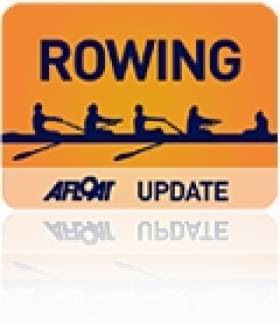Displaying items by tag: Sinead Jennings
#IrishRowingChampionships: Experience counts in difficult conditions, and the water became very choppy for the second session of finals at the Irish Rowing Championships. Sinead Jennings described it as “the hardest conditions I have rowed in” but the 36-year-old former world champion stayed out in front of Orla Hayes to win the lightweight single sculls. Catríona Jennings battled hard in the novice single sculls but had to settle for fourth, in a race won by Emily Hegarty of Skibbereen.
The final of the women’s senior pair was also a battle – but one which the NUIG crew of Lisa Dilleen and Aifric Keogh had won with hundreds of metres to go. Their closest rivals were Ailish Sheehan and Emily Tormey of St Michael’s – the two rowers who will join them in the Ireland four at the World Under-23 Championships next week.
The duel between Skibbereen and Shandon in the men’s junior quadruple sculls was also a fascinating one, with Shandon coming out on top by the closing stages. However Aodhán Burns of Skibbereen left the destination of the title in no doubt in the intermediate single - he led all the way down the course.
What Albert Maher called the “mileage” put in by the Commercial senior quadruple stood to them in their contest with a brave UCD crew which continued to fight it out down the course.
The junior women’s eight of Galway Rowing Club brought the club their second title of the day with a good win. Remarkably, the eight rowers – Femhe Caffrey, Claire Caulfield, Cara Cunningham, Ruth Cummins, Megan Donnelly, Kellie Wade, Fiona Murtagh and Clare Elwood – had also won this title last year. Last year they were coxed by Affraic O’Regan, while his year Normagh Heaney coxed the crew.
Irish Rowing Championships, National Rowing Centre, Farran Woods, Cork – Day Two
Men
Eight – Intermediate: 1 NUIG, 2 UCD, 3 UCC.
Pair – Senior: 1 Galway RC A (A Miller, M Ewing) 7:29, 2 NUIG (R Bennett, R O’Callaghan) 7:30, 3 St Michael’s B (D Power, K O’Connor) 7:44.
Sculling, Quadruple – Senior: 1 Commercial 7:17, 2 UCD 7:19, 3 Skibbereen 7:28. Junior: 1 Shandon 7:16, 2 Skibbereen 7:21, 3 Lee 7:31.
Single – Intermediate: 1 Skibbereen (A Burns) 9:04, 2 Shannon (Carmody) 9:12.78, 3 Clonmel (Prendergast) 9:13.29. Novice: 1 Portadown (S McKeown) 8:21, 2 Athlone (Munnelly) 8:24, 3 University of Limerick (Haugh) 8:28.
Women
Eight – Junior: 1 Galway RC 8:11, 2 Portora 8:20, 3 Bann 8:24.
Pair – Senior: 1 NUIG (A Keogh, L Dilleen) 9:11, 2 St Michael’s RC 9:22, 3 Skibbereen 9:45.
Sculling, Quadruple – Senior: 1 Skibbereen/Killorglin, 2 Commercial/ Three Castles.
Double – Intermediate: 1 NUIG (C Hurst, A Keogh), 2 Trinity, 3 St Michael’s.
Single – Lightweight: 1 St Michael’s (S Jennings) 9:51, 2 Skibbereen (O Hayes) 9:56, 3 St Michael’s (S Clavin) 10.29. Novice: 1 Skibbereen (E Hegarty) 10:42, 2 Commercial (Foley) 10:52, 3 Queen’s (Edwards) 11:10. Junior: 1 Fermoy (H Shinnick) 9:20, 2 Belfast (K Turner) 9:44, 3 Carrick-on-Shannon (C Kelly) 9:48.























